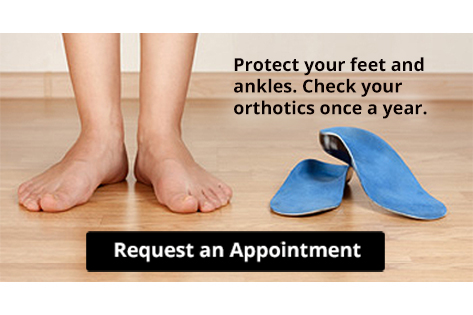February 2019
Flat Feet
Flatfoot is a foot condition in which the arch of the foot has either partially or totally dropped or has never developed. While it is common in babies and small children, it can become a problem for them in adulthood if the arch never forms. For adults, the development of flat feet can be brought upon by injury, as a result of pregnancy due to increased elasticity, or obesity. Those who have health concerns such as rheumatoid arthritis or diabetes may also be at greater risk for developing the condition.
If you suspect that you have flat feet, it is best to consult your podiatrist. Your foot doctor will examine the suspected foot and observe how it looks while you sit and stand. He or she may take an X-ray to determine how serious the condition is. Some common signs of flatfoot include toe drift, in which the toes and front part of the foot point outward, a short Achilles tendon, and a heel that tilts outwardly while the ankle tilts inward.
Once flatfoot has been diagnosed, your podiatrist may suggest one of several treatment options. Flat feet can be rigid, in which the feet appear to have no arch even when the person is not standing; or flexible, in which the person appears to have an arch while not standing, but once standing the arch disappears. Those with flexible flatfoot may be told to reduce any activities that cause pain and to avoid extended periods of walking or standing. Another suggestion may be weight loss, as excessive weight may be placing pressure on the arches
In few cases, if the condition is severe and all other methods have been exhausted surgery may be required. This is normally avoided, however, due to a lengthy recovery time and high cost.
Causes and Symptoms of Flat Feet
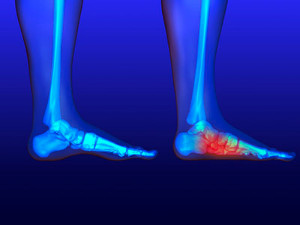 Fallen arches, which is also referred to as flat feet, occurs when the arch is absent from the foot. This can be noticed when the foot lies completely flat on the floor while standing. The foot may roll inward while walking, and this may affect the gait. The purpose of the arch is to help in distributing weight across the feet, which is the foundation of the body. Some patients do not experience symptoms with flat feet, and some people may feel pain as stress is put on the muscles and ligaments. A symptom may include swollen feet where the arch would generally be, and shoes may wear unevenly on one side. Foot or ankle injuries may cause this condition, in addition to predisposed genetic traits. Obesity and pregnancy may play a significant role in developing flat feet, and age may deteriorate the tendon, which supports the arch. If you feel you have this condition, it is advised to speak to a podiatrist who can offer proper treatment options.
Fallen arches, which is also referred to as flat feet, occurs when the arch is absent from the foot. This can be noticed when the foot lies completely flat on the floor while standing. The foot may roll inward while walking, and this may affect the gait. The purpose of the arch is to help in distributing weight across the feet, which is the foundation of the body. Some patients do not experience symptoms with flat feet, and some people may feel pain as stress is put on the muscles and ligaments. A symptom may include swollen feet where the arch would generally be, and shoes may wear unevenly on one side. Foot or ankle injuries may cause this condition, in addition to predisposed genetic traits. Obesity and pregnancy may play a significant role in developing flat feet, and age may deteriorate the tendon, which supports the arch. If you feel you have this condition, it is advised to speak to a podiatrist who can offer proper treatment options.
Flatfoot is a condition many people suffer from. If you have flat feet, contact Dr. Lee R. Stein from Lake Shore Foot & Ankle, PC. Our doctor will treat your foot and ankle needs.
What Are Flat Feet?
Flatfoot is a condition in which the arch of the foot is depressed and the sole of the foot is almost completely in contact with the ground. About 20-30% of the population generally has flat feet because their arches never formed during growth.
Conditions & Problems:
Having flat feet makes it difficult to run or walk because of the stress placed on the ankles.
Alignment – The general alignment of your legs can be disrupted, because the ankles move inward which can cause major discomfort.
Knees – If you have complications with your knees, flat feet can be a contributor to arthritis in that area.
Symptoms
- Pain around the heel or arch area
- Trouble standing on the tip toe
- Swelling around the inside of the ankle
- Flat look to one or both feet
- Having your shoes feel uneven when worn
Treatment
If you are experiencing pain and stress on the foot you may weaken the posterior tibial tendon, which runs around the inside of the ankle.
If you have any questions please feel free to contact one of our offices located in Chicago, Highland Park, and Uptown, IL . We offer the newest diagnostic and treatment technologies for all your foot and ankle needs.
Reminder: When Was the Last Time...?
Solutions for Cracked Heels
Cracked heels may make you want to think twice about showing off your feet in warmer weather. However, cracked heels may be harmful to more than just the appearance of your feet. If deep fissures and cracks develop in your heels, they may make walking and standing painful for you. Additionally, these openings make way for germs to enter through your skin and cause infection.
There are several different causes of cracked heels. One of the most common reasons for this ailment is dry skin. This problem may make your keeps feel rough tight and itchy. Dry skin may be caused by cold air, extremely hot water, harsh soaps, and aging. Skin disorders such as eczema and psoriasis may eventually lead to dry skin. In some cases, complications may arise from cracked heels. Some of these complications are a loss of feeling in the heel, cellulitis, or a diabetic foot ulcer.
There are ways you can try to prevent getting cracked heels. One of the best ways to do so is to avoid wearing flip flops and sandals because these shoes increase your risk of drying out your feet. You should also avoid wearing shoes with a tall skinny heel, because these shoes cause your heel to expand sideways. At night, you should slather on a thick moisturizing cream on your feet and then cover them in socks to keep your feet moisturized overnight. Drinking water to stay hydrated is also a good way to ensure that your skin doesn’t become dry.
If you suffer from a severe case of cracked feet, you should make an appointment with your podiatrist to see what treatment methods are best for you.
What Causes Cracked Heels?
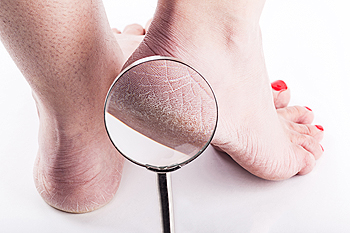 The uncomfortable condition known as cracked heels may develop for a variety of reasons.These may include standing for extended periods of time, wearing shoes that have an open back, or existing medical conditions such as eczema or psoriasis. The noticeable symptoms of cracked heels often include thickened skin in the heel area, and cracks, or fissures appearing at the end of the heel. Pain and discomfort are often associated with this condition, and mild relief may be obtained by washing and drying the feet frequently, followed by utilizing a good moisturizer. If the fissures should become deep, it is suggested that you seek the counsel of a podiatrist who can properly diagnosis and treat this condition.
The uncomfortable condition known as cracked heels may develop for a variety of reasons.These may include standing for extended periods of time, wearing shoes that have an open back, or existing medical conditions such as eczema or psoriasis. The noticeable symptoms of cracked heels often include thickened skin in the heel area, and cracks, or fissures appearing at the end of the heel. Pain and discomfort are often associated with this condition, and mild relief may be obtained by washing and drying the feet frequently, followed by utilizing a good moisturizer. If the fissures should become deep, it is suggested that you seek the counsel of a podiatrist who can properly diagnosis and treat this condition.
If the skin on your feet starts to crack, you may want to see a podiatrist to find treatment. If you have any concerns, contact Dr. Lee R. Stein from Lake Shore Foot & Ankle, PC. Our doctor can provide the care you need to keep you pain-free and on your feet.
Cracked Heels
It is important to moisturize your cracked heels in order to prevent pain, bleeding, and infection. The reason cracked heels form is because the skin on the foot is too dry to support the immense pressure placed on them. When the foot expands, the dry skin on the foot begins to split.
Ways to Help Heal Them
- Invest in a good foot cream
- Try Using Petroleum Jelly
- Ease up on Soaps
- Drink Plenty of Water
Ways to Prevent Cracked Heels
- Moisturize After Showering
- Skip a Shower
- Keep Shower Water Lukewarm
- Don’t Scrub Your Feet
If you are unsure how to proceed in treating cracked heels, seek guidance from a podiatrist. Your doctor will help you with any questions or information you may need.
If you have any questions, please feel free to contact one of our offices located in Chicago, Highland Park, and Uptown, IL . We offer the newest diagnostic and treatment technologies for all your foot care needs.
Hyperhidrosis of the Feet
Hyperhidrosis of the feet, also termed plantar hyperhidrosis, is characterized by excessive sweating of the feet that can be onset by any cause, such as exercise, fever, or anxiety. Most people suffering from hyperhidrosis of the feet also experience hyperhidrosis of the hands, or palmar hyperhidrosis. Approximately 1-2% of Americans suffer from this disorder.
Sweating is a healthy process utilized by the body in order to cool itself and maintain a proper internal temperature, which is controlled by the sympathetic nervous system. In individuals with hyperhidrosis, the sympathetic nervous system works in "overdrive", producing far more sweat than is actually needed.
Plantar hyperhidrosis is considered primary hyperhidrosis. Secondary hyperhidrosis refers to excessive sweating that occurs in an area other than the feet, hands, or armpits, and this indicates that is related to another medical condition, such as menopause, hyperthyroidism, or Parkinson's disease.
Symptoms of hyperhidrosis of the feet can include foot odor, athlete's foot, infections, and blisters. Because of the continual moisture, shoes and socks can rot which creates an additional foul odor and can ruin the material, requiring shoes and socks to be replaced frequently. In addition to the physical symptoms, emotional health is often affected as this disorder can be very embarrassing.
If left untreated, hyperhidrosis will usually persist throughout an individual's life. However, there are several treatment options available. A common first approach to treating hyperhidrosis of the feet is a topical ointment. Aluminum chloride, an ingredient found in antiperspirants, can be effective at treating hyperhidrosis if used in high concentration and applied to the foot daily. Some individuals can experience relief this way, while others encounter extreme irritation and are unable to use the product. Another procedure is the use of Botulinum Toxin A, commonly referred to as Botox. This is injected directly into the foot, and is effective at minimizing the sweat glands in the injected area. These injections must be repeated every 4 to 9 months.
If these treatments are ineffective, oral prescription medications may be taken in an effort to alleviate the symptoms. Again, some will experience relief while others do not. Going barefoot reportedly provides relief for most sufferers.
A final approach to combating hyperhidrosis of the feet is through surgery. Surgery has been less successful on patients with plantar hyperhidrosis than on those with palmar hyperhidrosis. It is only recommended when sweating is severe and other treatments have failed to work. This kind of surgery usually involves going into the central nervous system, and cutting nerves to stop the transmission of signals telling the foot to sweat.
Causes of Plantar Hyperhidrosis
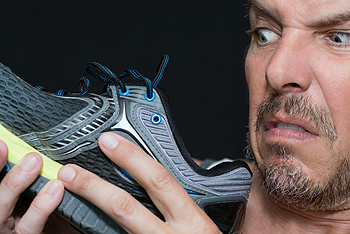 Many people experience excessive sweating on the soles of their feet, and this is referred to as plantar hyperhidrosis. This condition may be a result of overactive sweat glands, and may be triggered by hot weather, eating spicy food, or exercising for extended periods of time. Additionally, there may be existing medical conditions which may contribute to causing this condition, including peripheral or spinal nerve damage, anxiety disorders, or obesity. There are several symptoms that may be noticeable in plantar hyperhidrosis, and these may include an unpleasant odor coming from the soles of the feet, athlete’s foot, or chronic blistering. There may be measures that can be taken to feel more comfortable, and this can be done by changing the shoes when they becomes damp, or replacing absorbent insoles frequently. If you are suffering from this foot condition, it is advised to speak to a podiatrist who can properly diagnose and treat plantar hyperhidrosis.
Many people experience excessive sweating on the soles of their feet, and this is referred to as plantar hyperhidrosis. This condition may be a result of overactive sweat glands, and may be triggered by hot weather, eating spicy food, or exercising for extended periods of time. Additionally, there may be existing medical conditions which may contribute to causing this condition, including peripheral or spinal nerve damage, anxiety disorders, or obesity. There are several symptoms that may be noticeable in plantar hyperhidrosis, and these may include an unpleasant odor coming from the soles of the feet, athlete’s foot, or chronic blistering. There may be measures that can be taken to feel more comfortable, and this can be done by changing the shoes when they becomes damp, or replacing absorbent insoles frequently. If you are suffering from this foot condition, it is advised to speak to a podiatrist who can properly diagnose and treat plantar hyperhidrosis.
If you are suffering from hyperhidrosis contact Dr. Lee R. Stein of Lake Shore Foot & Ankle, PC. Our doctor can provide the care you need to attend to all of your foot and ankle needs.
Hyperhidrosis of the Feet
Hyperhidrosis is a rare disorder that can cause people to have excessive sweating of their feet. This can usually occur all on its own without rigorous activity involved. People who suffer from hyperhidrosis may also experience sweaty palms.
Although it is said that sweating is a healthy process meant to cool down the body temperature and to maintain a proper internal temperature, hyperhidrosis may prove to be a huge hindrance on a person’s everyday life.
Plantar hyperhidrosis is considered to be the main form of hyperhidrosis. Secondary hyperhidrosis can refer to sweating that occurs in areas other than the feet or hands and armpits. Often this may be a sign of it being related to another medical condition such as menopause, hyperthyroidism and even Parkinson’s disease.
In order to alleviate this condition, it is important to see your doctor so that they may prescribe the necessary medications so that you can begin to live a normal life again. If this is left untreated, it is said that it will persist throughout an individual’s life.
A last resort approach would be surgery, but it is best to speak with your doctor to find out what may be the best treatment for you.
If you have any questions please feel free to contact one of our offices located in Chicago, Highland Park, and Uptown, IL . We offer the newest diagnostic and treatment technologies for all your foot and ankle needs.
Why Live with Pain and Numbness in Your Feet?
Rheumatoid Arthritis in the Feet
Although rheumatoid arthritis attacks multiple bones and joints throughout the entire body, ninety percent of people who actually develop this condition usually do so in the foot or ankle area. Those who develop this kind of arthritis in the feet usually develop symptoms around the toes and forefeet first, before anywhere else. Rheumatoid arthritis appears to have a genetic component. If it runs in the family, then you will be more likely to develop it as well.
Rheumatoid arthritis is an autoimmune disorder in which the body’s own immune system attacks the lining of the membranes surrounding the joints. This causes inflammation of the membrane lining, and the gradual destruction of the joint’s cartilage and even bone.
Some of the most common symptoms that are associated with RA include pain and swelling of the feet. Stiffness in the feet is also another common symptom that people experience. Those who have RA in the feet usually feel the pain in the ball or sole of their feet. This can get to be very painful at times. A person's joints can even shift and become deformed after a period of time.
In order to properly diagnose RA in the feet it is usually necessary for a doctor or podiatrist to evaluate the area. Your doctor will also question you about your medical history, occupation, etc., to determine whether anything in your lifestyle may have triggered the condition. There are a number of tests that may be performed to help diagnose RA, such as a rheumatoid factor test. There is, however, no one single test that will tell you for sure if you have RA. There are different X-rays that can be taken as well to determine if a person has RA in their feet.
There is a range of treatment options for rheumatoid arthritis. Treatment of RA is usually a lifelong process that includes a variety of methods of treatment and therapy. Your doctor can prescribe special shoes that should help with arch support as well as heel support. A physical therapist can help those with this condition learn exercises which will keep their joints flexible. Surgery may be needed to correct some of the issues with the feet, such as bunions, and hammertoes. Fusion is usually the most successful surgical option for rheumatoid arthritis. However, people need to keep in mind that there are some risks associated with these surgeries.
Understanding Rheumatoid Arthritis
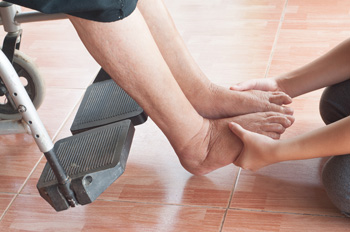 Rheumatoid arthritis affects about 1.5 million people in the United States and is a very serious disease. It is an autoimmune disease that causes the body’s immune system to mistakenly attack joints. This attack creates inflammation that causes the tissue lining on the joints to thicken, which causes pain and swelling. It is important to catch this inflammation early, because over time it can damage cartilage, elastic tissue that covers bones in the joint, and the bones themselves. This damage can lead to the joint spacing between bones to shrink, which causes joints to become loose, unstable and painful. Joint deformity is also a possibility, and this cannot be reversed. Rheumatoid arthritis usually occurs symmetrically, so if one foot or ankle is affected then the other one most likely will be too. If you feel that you have any symptoms of Rheumatoid arthritis, it is highly recommended that you speak with a podiatrist to start treatment as soon as possible.
Rheumatoid arthritis affects about 1.5 million people in the United States and is a very serious disease. It is an autoimmune disease that causes the body’s immune system to mistakenly attack joints. This attack creates inflammation that causes the tissue lining on the joints to thicken, which causes pain and swelling. It is important to catch this inflammation early, because over time it can damage cartilage, elastic tissue that covers bones in the joint, and the bones themselves. This damage can lead to the joint spacing between bones to shrink, which causes joints to become loose, unstable and painful. Joint deformity is also a possibility, and this cannot be reversed. Rheumatoid arthritis usually occurs symmetrically, so if one foot or ankle is affected then the other one most likely will be too. If you feel that you have any symptoms of Rheumatoid arthritis, it is highly recommended that you speak with a podiatrist to start treatment as soon as possible.
Because RA affects more than just your joints, including the joints in your feet and ankles, it is important to seek early diagnosis from your podiatrist if you feel like the pain in your feet might be caused by RA. For more information, contact Dr. Lee R. Stein of Lake Shore Foot & Ankle, PC. Our doctor will assist you with all of your podiatric concerns.
What Is Rheumatoid Arthritis?
Rheumatoid Arthritis (RA) is an autoimmune disorder in which the body’s own immune system attacks the membranes surrounding the joints. Inflammation of the lining and eventually the destruction of the joint’s cartilage and bone occur, causing severe pain and immobility.
Rheumatoid Arthritis of the Feet
Although RA usually attacks multiple bones and joints throughout the entire body, almost 90 percent of cases result in pain in the foot or ankle area.
Symptoms
- Swelling and pain in the feet
- Stiffness in the feet
- Pain on the ball or sole of feet
- Joint shift and deformation
Diagnosis
Quick diagnosis of RA in the feet is important so that the podiatrist can treat the area effectively. Your doctor will ask you about your medical history, occupation, and lifestyle to determine the origin of the condition. Rheumatoid Factor tests help to determine if someone is affected by the disease.
If you have any questions please feel free to contact one of our offices located in Chicago, Highland Park, and Uptown, IL . We offer the newest diagnostic and treatment technologies for all your foot and ankle needs.
Featured Articles
- April 2025
- March 2025
- February 2025
- January 2025
- December 2024
- November 2024
- October 2024
- September 2024
- August 2024
- July 2024
- June 2024
- May 2024
- April 2024
- March 2024
- February 2024
- January 2024
- December 2023
- November 2023
- October 2023
- September 2023
- August 2023
- July 2023
- June 2023
- May 2023
- April 2023
- March 2023
- February 2023
- January 2023
- December 2022
- November 2022
- October 2022
- September 2022
- August 2022
- July 2022
- June 2022
- May 2022
- April 2022
- March 2022
- February 2022
- January 2022
- December 2021
- November 2021
- October 2021
- September 2021
- August 2021
- July 2021
- June 2021
- May 2021
- April 2021
- March 2021
- February 2021
- January 2021
- December 2020
- November 2020
- October 2020
- September 2020
- August 2020
- July 2020
- June 2020
- May 2020
- April 2020
- March 2020
- February 2020
- January 2020
- December 2019
- November 2019
- October 2019
- September 2019
- August 2019
- July 2019
- June 2019
- May 2019
- April 2019
- March 2019
- February 2019
- January 2019
- December 2018
- November 2018
- October 2018
- September 2018
- August 2018
- July 2018



